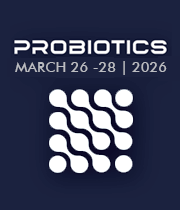Title : Metagenomic analysis of non-dairy fermented foods reveals food source associated differences in taxonomy, biosynthesis of secondary metabolites and xenobiotic degradation
Abstract:
Background and objectives: Recent studies have suggested that healthy diets should include fermented foods to enhance probiotics as live beneficial microorganisms in our gut. The need for non-milk based fermented foods has arisen in lactose intolerants, those allergic to milkproteins, vegans, due to high fat and cholesterol content in dairy products. However, the mechanisms underlying the health benefits accruing from the non-milk fermented food microbiome are not clearly understood. The present stud aims to attain a comprehensive insight into the structural and functional composition of microbiomes by metagenomic analysis of a diverse range of non-dairy based fermented products traditionally used across a number of countries.
Methods: MiSeq single-end fastq sequences of 16S rRNA bacterial genes were fetched using SRA (https://www.ncbi.nlm.nih.gov/sra), pertaining to 23 non-dairy fermented food samples (9 datasets) including pickles (n=3), sauerkraut (n=3), whole wheat (n=2), sourdough (fermented spontaneously or by inoculation, n=3, each), Arabian foods (n=2), olives (n=2), carrot juice (n=3), and pozol (n=2). The sequences were imported to QIIME2 (https://qiime2.org) in Miniconda-3, and subjected to demultiplexing, quality control with Dada2 algorithm, phylogenetic analysis, and taxonomic classification using GREENGENES. Statistical analysis for community profiling was achieved with alpha-, beta diversity, and core microbiome analysis; clustering analysis with heatmap to compare abundance of different taxonomic levels, dendrogram, correlation analysis, pattern search; differential abundance analysis with univariate statistics, and marker-gene survey with metagenomeSeq (https://www.microbiomeanalyst.ca). The PICRUSt was used for rediction of the functional potential and pathway analysis of the microbiota from 16S output (https://www.microbiomeanalyst.ca).
Results: The study revealed that the fermentation source and food types were the major drivers of
microbial composition, with pozol and whole wheats demonstrating respectively the highest and lowest effect on microbial diversity, while inoculated sourdough exhibited highest species richness.
Functionally, pickles and dough were more diverse and rich respectively, while saurkraut displayed no effect on microbial community function. Genes related to ATP-binding cassette type transport system were dominant, essential in nutrient uptake, cell viability, protein secretion, signal transduction, drug and antibiotic resistance. Lactobacillus was consistently abundant in carrot juice, spontaneous sourdough, pozol, and whole wheat while Lactococcus, Leuconostoc, and Weisella were abundant in carrot juice only, the four beneficial lactic acid bacteria with established probiotic potentiality. Bacterial strains of the genus Sphingomonas with projected bioremediation capacity, was predominant in spontaneously fermented sourdough. The presence of genes related to the degradation of atrazine, styrene, geraniol, caprolactam, limonene, pinene, toluene, ethylbenzene, polycyclic aromatic hydrocarbon, and fluorobenzoate might be useful in restoring environmental quality. This study revealed the abundance of genes related to the biosynthesis of penicillin, cephalosporin, stilbenoid, diarylheptanoid, gingero, flavonoid, carotenoid, and ansamycins with possible industrial application. On the other hand, involvement of pathogenic bacterial genera such as Clostridium, Corynebacterium, Pseudomonas, Escherichia, Rhodococcus, Streptococcus in pickles cannot be ruled out for major health concern to the consuming population.
Conclusions: Non-dairy genomics may be applied for monitoring the microbial composition and functionality to obtain candidate non-dairy starter strains, towards development of functional food with desirable gene traits, and assessing the safety of the traditional non-milk fermented foods.




